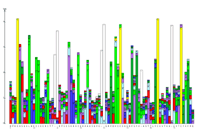 LogoBar
LogoBar

 LogoBar LogoBar
 |
| Download LogoBar |
Sample files & examples |
Detailed features |
Documentation |
| To
Bürglin Lab Home Page |
Other Software |
| Compressed executable for Mac Os X This is a double-clickable application that runs in Mac Os X. It requires Java 1.4.2, so should run on Mac Os X 10.3 and 10.4 Note: the "File Open" dialog behaves like in a unix environment, not like MacOsX. |
| Jar
files for any computer system In order to run Java software on your computer JVM (Java Virtual Machine) has to be installed on the computer. This can be downloaded for free at Sun's web pages at http://java.sun.com These versions are from 20.4.2006 Zipped package: LogoBar-0.91, This version requires Java 1.4 Zipped package: LogoBar-0.912, This version requires Java 1.5 Alternatively, download the two jar files (LogoBar.jar and epsgraphics.jar) to your computer, and place them in the same directory. This version requires Java 1.4 The Java EPS Graphics2D package (epsgraphics.jar) package is developed by Paul Mutton and is available under the GNU general public license. To run LogoBar, open a terminal window, move to the directory with the LogoBar.jar file and type: java -jar LogoBar.jar See also the README file. |